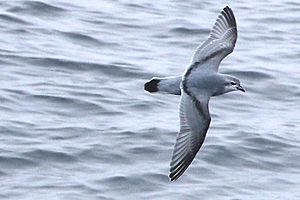Fulmar prion facts for kids
Quick facts for kids Fulmar prion |
|
|---|---|
 |
|
| Conservation status | |
| Scientific classification | |
| Genus: |
Pachyptila
|
| Species: |
crassirostris
|
| Subspecies | |
|
P. crassirostris crassirostris |
|
The fulmar prion (Pachyptila crassirostris) is a small seabird. It belongs to the petrel family. You can find these birds flying over the southern parts of the world's oceans.
Contents
What's in a Name?
The common name "prion" means "saw." This is because of the bird's special beak. It has small comb-like plates inside. The word "fulmar" means "foul-gull." This name might come from their strong smell.
The scientific group name, Pachyptila, means "thick feathers." The specific name crassirostris means "thick-beaked." All these names tell us something about this unique bird!
Bird Family and Features
The fulmar prion is part of a group called prions. These birds are small. They mostly eat tiny ocean creatures called zooplankton. Prions are also part of a larger bird family. This family is called Procellariidae.
Birds in this family have some cool features:
- They have special nasal passages. These are called naricorns. They attach to the top part of their beak.
- Their beaks are unique. They are made of 7 to 9 hard plates.
- They can make a special stomach oil. This oil is stored in their stomach. They use it in two ways. First, they can spit it at predators to scare them away. Second, it's a super-rich food source. Parents feed it to their chicks. Adults also use it for energy during long flights.
- They have a salt gland above their nose. This gland helps them drink seawater. It removes the salt from their bodies. They then get rid of the salty water from their nostrils.
Types of Fulmar Prions
There are two types, or subspecies, of the fulmar prion:
- Pachyptila crassirostris crassirostris: This type nests on the Snares Islands, Chatham Islands, and Bounty Islands.
- Pachyptila crassirostris eatoni: This type nests on Heard Island and the Auckland Islands.
Life Cycle
Fulmar prions breed once a year. They lay just one egg. They make their nests on islands in large groups called colonies.
Both the male and female birds take turns sitting on the egg. This is called incubating. It takes about 45 days for the egg to hatch. After the chick hatches, both parents feed it. The chick stays in the nest for about 46 days. Then it is ready to fledge and fly on its own.
What They Eat
Like all prions, fulmar prions mainly eat zooplankton. These are tiny animals that float in the ocean. The prions have a special way to eat them. They use their upper bill to strain the zooplankton from the water. It works like a sieve!
Where They Live
Fulmar prions are pelagic birds. This means they spend most of their lives out at sea. They fly over the southern oceans.
When it's time to breed, they come to land. They nest on islands like Heard Island, Auckland Islands, Chatham Islands, Bounty Islands, and Snares Island.
Protecting Fulmar Prions
The fulmar prion lives across a very large area. Even though their numbers are not as high as some other prions, there are still many of them. Scientists believe there are between 150,000 and 300,000 adult birds.
Because of these good numbers, the IUCN says they are of "Least Concern." This means they are not currently in danger of disappearing.
See also
 In Spanish: Pato petrel picogrueso para niños
In Spanish: Pato petrel picogrueso para niños


